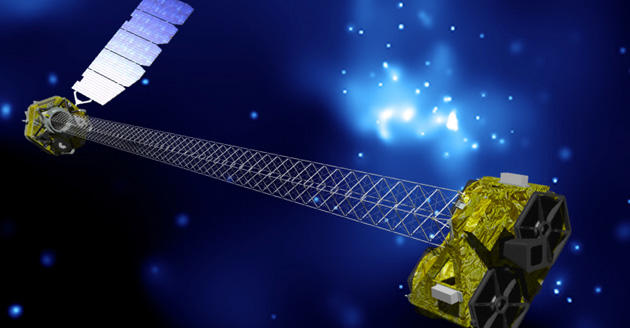NuSTAR space telescope is scheduled for launch today - will search for undiscovered black holes in the Milky Way -

A once-canceled space telescope is set to launch into Earth orbit, where it will search for undiscovered black holes in the Milky Way and at the hearts of other galaxies.
The Nuclear Spectroscopic Telescope Array will hunt for black holes that have been obscured by the dust and gas floating through space and measure how fast some of them are spinning. NuSTAR will also examine with fresh eyes the remnants of exploded stars known as supernovae.
"It's a very exciting mission," said Roger Blandford, director of the Kavli Institute of Particle Astrophysics and Cosmology at Stanford University and a member of the NuSTAR science team. "It opens up a new window on the universe."
Black holes, supernovae and other cosmic sources can give off light across the whole electromagnetic spectrum, from low-energy infrared waves to high-energy gamma radiation. But much of that light is invisible even to the Hubble Space Telescope and the ChandraX-rayObservatory, which are focused on the infrared, visible, ultraviolet and low-energyX-rayportions of the spectrum.
In addition, much of the lower-energy light gets absorbed by gas and dust floating through space, essentially blocking these objects from view.
NuSTAR will capture high-energyX-raysemanating from these cosmic bodies. But it's hard for instruments to detect the rays directly — they tend to go straight through. These are, after all, the same kind of X-rays dentists use to penetrate your skin and take images of your teeth, explained Caltech astrophysicist Fiona Harrison, the mission's principal investigator.
To catch these X-rays, NuSTAR will position its highly reflective mirrors at an angle that's almost parallel to incoming light. That way, when an X-ray hits the mirrors at such a glancing angle, it can then be bounced right into the detector, about 30 feet away at the end of a mast.
The steep angle reduces the amount of light that can be captured, so to compensate, NuSTAR's mirrors are arranged in 133 conical nested shells, like so many Russian dolls.
Read more -
http://www.latimes.com/news/science/la-sci-nustar-black-holes-20120613,0,7768940.story

A once-canceled space telescope is set to launch into Earth orbit, where it will search for undiscovered black holes in the Milky Way and at the hearts of other galaxies.
The Nuclear Spectroscopic Telescope Array will hunt for black holes that have been obscured by the dust and gas floating through space and measure how fast some of them are spinning. NuSTAR will also examine with fresh eyes the remnants of exploded stars known as supernovae.
"It's a very exciting mission," said Roger Blandford, director of the Kavli Institute of Particle Astrophysics and Cosmology at Stanford University and a member of the NuSTAR science team. "It opens up a new window on the universe."
Black holes, supernovae and other cosmic sources can give off light across the whole electromagnetic spectrum, from low-energy infrared waves to high-energy gamma radiation. But much of that light is invisible even to the Hubble Space Telescope and the ChandraX-rayObservatory, which are focused on the infrared, visible, ultraviolet and low-energyX-rayportions of the spectrum.
In addition, much of the lower-energy light gets absorbed by gas and dust floating through space, essentially blocking these objects from view.
NuSTAR will capture high-energyX-raysemanating from these cosmic bodies. But it's hard for instruments to detect the rays directly — they tend to go straight through. These are, after all, the same kind of X-rays dentists use to penetrate your skin and take images of your teeth, explained Caltech astrophysicist Fiona Harrison, the mission's principal investigator.
To catch these X-rays, NuSTAR will position its highly reflective mirrors at an angle that's almost parallel to incoming light. That way, when an X-ray hits the mirrors at such a glancing angle, it can then be bounced right into the detector, about 30 feet away at the end of a mast.
The steep angle reduces the amount of light that can be captured, so to compensate, NuSTAR's mirrors are arranged in 133 conical nested shells, like so many Russian dolls.
Read more -
http://www.latimes.com/news/science/la-sci-nustar-black-holes-20120613,0,7768940.story

No comments:
Post a Comment